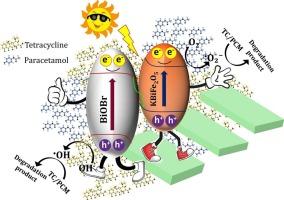原位工程KBiFe2O5/BiOBr Z-scheme异质结光催化剂用于制药污染物降解和固氮
IF 6.9
2区 材料科学
Q2 CHEMISTRY, PHYSICAL
引用次数: 0
摘要
本文采用原位水热法制备了多功能z型异质结光催化剂KBiFe2O5/BiOBr (KBF-BB-I)。透射电镜证实了紧密异质结的形成,棒状KBiFe2O5均匀地锚定在板状BiOBr上。与沉淀衍生的对应物(KBF-BB)相比,原位方法增强了界面接触和能带对准,促进了有效的电荷分离和界面转移。在可见光照射下,kbf - b - 1表现出优异的光催化活性,在60 min内,对四环素(TC)和对乙酰氨基酚(PCM)的降解率分别达到97% %和90% %。本文首次报道了KBiFe2O5与BiOBr结合用于制药污染物降解和固氮的研究。复合材料也具有固氮作用,在240 min后产生6 mmol L−1g−1的氨。光致发光和Mott-Schottky分析证实了抑制的电子-空穴复合和有利的能带对准,支持直接的Z-scheme机制。自由基捕获实验证实了关键活性氧(•O2 -,•OH)的生成。该催化剂具有良好的稳定性和可重复使用性。这种增强的性能源于界面工程、高表面积和高效电荷迁移的协同效应,使KBF-BB-I成为一种有前景的环境修复光催化剂。本文章由计算机程序翻译,如有差异,请以英文原文为准。

In-situ engineered KBiFe2O5/BiOBr Z-scheme heterojunction photocatalyst for the pharmaceutical pollutant degradation and nitrogen fixation
This study reports the rational design of a multifunctional Z-scheme heterojunction photocatalyst, KBiFe2O5/BiOBr (KBF-BB-I), synthesized via an in-situ hydrothermal method. Transmission electron microscopy confirmed the formation of an intimate heterojunction, with rod-like KBiFe2O5 uniformly anchored on plate-like BiOBr. Compared to the precipitation-derived counterpart (KBF-BB), the in-situ approach enhanced interfacial contact and band alignment, promoting efficient charge separation and interfacial transfer. Under visible light irradiation, KBF-BB-I exhibited outstanding photocatalytic activity, achieving 97 % degradation of tetracycline (TC) and 90 % of paracetamol (PCM) within 60 min, both individually and in binary mixtures. This is the first report on integration of KBiFe2O5 with BiOBr for pharmaceutical pollutant degradation and nitrogen fixation. The composite also demonstrated nitrogen fixation, producing 6 mmol L−1g−1 of ammonia after 240 min. Photoluminescence and Mott-Schottky analyses confirmed suppressed electron-hole recombination and favourable band alignment, supporting a direct Z-scheme mechanism. Radical trapping experiments verified the generation of key reactive oxygen species (•O2–, •OH). The catalyst showed excellent stability and reusability. The enhanced performance arises from the synergistic effects of interfacial engineering, high surface area, and efficient charge migration, positioning KBF-BB-I as a promising photocatalyst for environmental remediation.
求助全文
通过发布文献求助,成功后即可免费获取论文全文。
去求助
来源期刊

Applied Surface Science
工程技术-材料科学:膜
CiteScore
12.50
自引率
7.50%
发文量
3393
审稿时长
67 days
期刊介绍:
Applied Surface Science covers topics contributing to a better understanding of surfaces, interfaces, nanostructures and their applications. The journal is concerned with scientific research on the atomic and molecular level of material properties determined with specific surface analytical techniques and/or computational methods, as well as the processing of such structures.
 求助内容:
求助内容: 应助结果提醒方式:
应助结果提醒方式:


